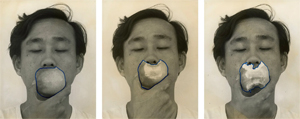12.4.23 — Seoul on Ice
Korea was changing fast back then, but not that fast. In his slideshow of life on the streets and in the news in Seoul, The Meaning of 1/24 Second, Kim Kulim does not come close to twenty-four frames per second. This is a photomontage, not a movie, and he knows it.
For all that, the world was spinning out of control, with only artists to give it substance and, just maybe, meaning. Does Kim exaggerate? Such is youth, and this is “Only the Young: Experimental Art in Korea,” at the Guggenheim through January 7, and it is the subject of a longer and fuller review in my latest upload. This was 1969, a time with a spectacular youth culture, the year of Woodstock and Abbey Road. Here in the West, too,  late Modernism was coming under assault. If art in Korea from the 1960s and 1970s seems less familiar and less consequential, it more than kept up.
late Modernism was coming under assault. If art in Korea from the 1960s and 1970s seems less familiar and less consequential, it more than kept up.
The very first work at the Guggenheim reels off the changes. Yet White Paper on Urban Planning, by Ha Chong-Hyun is neither white nor obviously urban. It is a colorful abstraction, on paper of course. It has no particular pattern holding together its soft curves, hard edges, and horizontal bulges, but then it casts doubt on the very possibility of planning. So does Kim, with The Death of the Sun and Tombstone. Someone must have planned for the future, but not for their thick, black, charred remains of vinyl, steel, and plastic.
Photographs next to both describe a newly westernized Korea, with only a touch of exaggeration, much like Kim’s slides. Fashionable young people crowd the streets, and black highways spin out from their intersection five ways. Whoever could plan for this? A Japanese invasion and World War II had left the peninsula divided, and the Korean War only confirmed the division. And those wars were only the start of an American presence. Global capitalism was bringing high rises, highways, industrial cities, and fashion.
Art responded, with its own scattershot attempt at organization. Movement after movement arose, with little to set off one from another. Kim helped found the Fourth Group, and I lost count after the Korean Avant-Garde Association, Space in Time, and whatever else. Their members made a point of not attending the official art show each year, although they had no qualms about exhibiting in biennials in São Paulo and Paris, where they made a hit. The madness leaves their retrospective with no clear themes or sequence. The curators, the Guggenheim’s Kyung An and Kang Soojung Korea of Korea’s National Museum of Modern and Contemporary Art, have three tower galleries for eighty works by half as many artists.
Abstraction appears often, but as collage, like three rows of four creased circles apiece by Ha Chong-Hyun. Ha Chong-Hyun constructs his dense monochromes from acrylic, cigarette butts, and matchsticks. He also lays barbed wire over coarse jute rather like burlap. As art, it has its inclusions and exclusions, like the middle class, the Demilitarized Zone, or a barbed-wire fence. Kim makes his abstraction from rows of light bulbs that will never light up. As painting, these are forgettable, but the point is their tactile value and the remains of the day.
Can there still be a uniquely experimental art? Was there ever? Regardless, their interest in film anticipates younger Asian artists turning to video art, including Korean video. Credit them, too, with a fluid space between stasis and change, abstraction and performance. As I left, I passed Gego on the museum ramp, from Venezuela. In light of Korea’s experiment, half a planet away, her wire constructions seemed newly relevant.
Read more, now in a feature-length article on this site.